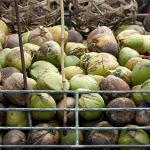Barbecue briquettes have become a staple in American backyard barbecues and picnics, providing an efficient and reliable source of heat for grilling meat, poultry, and vegetables. But where did barbecue briquettes come from, and how have they evolved over time?
In the early 1900s, Henry Ford, the founder of Ford Motor Company, was looking for a way to utilize the waste wood generated by his factories. He came up with the idea of creating charcoal briquettes by compressing sawdust and other wood scraps together with a binder, and then charring the mixture in a kiln. This process produced a consistent, efficient fuel that burned longer and hotter than traditional lump charcoal, making it ideal for cooking on a grill.
Ford’s charcoal briquettes became popular during the Great Depression, when many Americans were struggling to make ends meet and were looking for affordable ways to entertain themselves at home. Barbecuing became a popular pastime, and charcoal briquettes were a key component of the trend.
In the years since, charcoal briquettes have continued to evolve and improve. Today, there are a wide variety of briquette brands and formulations available, each with their own unique characteristics and advantages.
One of the most popular brands of barbecue briquettes in the USA is Kingsford. Kingsford was founded in the 1920s by a group of Ford employees who were looking for a way to use the excess wood scraps from Ford’s Model T production lines. They developed a charcoal briquette that was specifically designed for grilling, and marketed it to the public.
In recent years, there has been a growing interest in more eco-friendly alternatives to traditional charcoal briquettes. One option that has gained popularity is lump charcoal, which is made by burning natural hardwoods in the absence of oxygen. Lump charcoal produces less ash and fewer pollutants than traditional briquettes, and is often seen as a more sustainable option.
Another emerging trend in the world of barbecue briquettes is the use of coconut charcoal. Coconut charcoal is made from the shells of coconuts, which are burned at high temperatures to create a charcoal that burns hotter and longer than traditional charcoal briquettes. Coconut charcoal is also seen as a more eco-friendly option, as it utilizes a waste product that would otherwise be discarded.
In conclusion, barbecue briquettes have a long and storied history in the USA, evolving from a byproduct of the auto industry to a beloved component of American outdoor cooking culture. While traditional briquettes like Kingsford remain popular, there is growing interest in more sustainable and eco-friendly options like lump charcoal and coconut charcoal. Whatever your preference, barbecue briquettes are sure to remain a staple of American backyard barbecues for many years to come.









